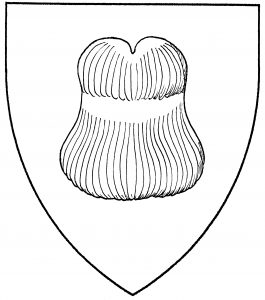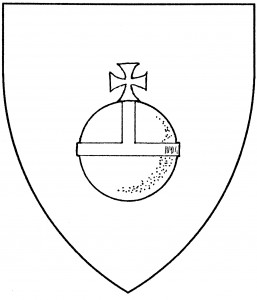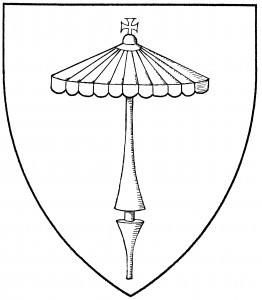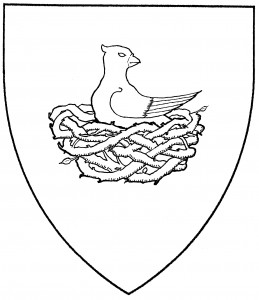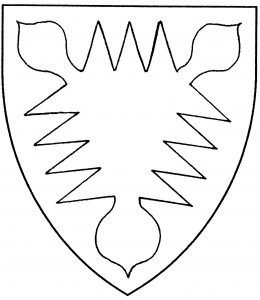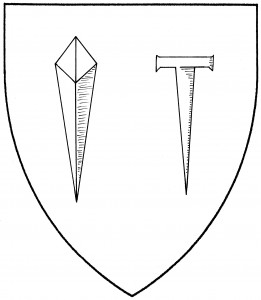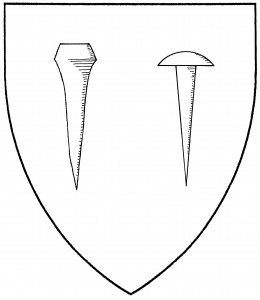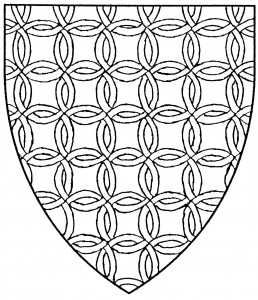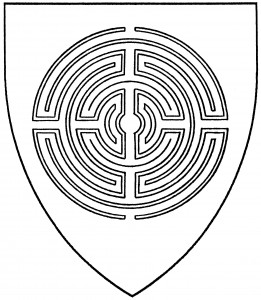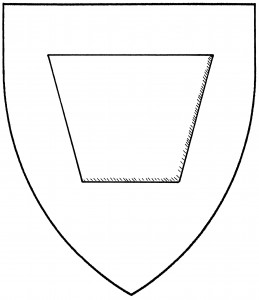Carlos Blanco el Barbero bears as a badge: Or, in pale a perruque gules and a sinister hand azure.
Moyai-Nidun bears as a badge: Gules, a perruque and on a chief argent a grenade sable.
Archives
Orb
An orb is a ball, banded and with a cross atop it; also called a “mound”, it is a symbol of the world (and thus, when used as regalia, of temporal sovereignty). As an heraldic charge, it’s found in the arms of Friellas c.1540 [Nobreza xxxiiº].
In Society heraldry, the term “orb” was once used to refer to a featureless ball, synonymous with a roundel. This usage is no longer followed; orbs and roundels are considered distinct charges, with difference granted. For related charges, see sphere.
Fionn mac Con Dhuibh bears: Azure, three orbs argent.
Randolph Wedderlie bears: Or, an orb gules.
Margrett Schwarzenberger bears: Per chevron argent and sable, three orbs counterchanged.
Ombrellino
An ombrellino is, in its simplest form, a sunshade or parasol; but the form used in heraldry is taken from the achievement of the Pope. In that form, it’s more ornate, frequently ensigned with a cross, and has a handle resembling a tilting spear. The ombrellino became an element of the most common form of Papal augmentation of arms, as in the arms of Cesare Borgia, 1502 [Galbreath’s Papal Heraldry, p.30].
Since the ombrellino was used in Papal augmentation, its use in the Society must not be too allusive to that augmentation. In practice, that means the ombrellino may not be used in conjunction with keys in saltire.
Luciana Caterina de Borghese bears: Vair, an ombrellino gules.
Nest
A nest is a roost for birds, consisting of a shallow bowl woven of wooden twigs; its “proper” tincture is therefore brown. It’s never found in period heraldry except when a bird is sitting in it, as in the crest of Nobrega, c.1540 [Nobreza xxº]. The illustration shows a dove reguardant sitting in a nest. See also birdcage.
The Order of the Cygnets Nest, of Meridies, bears: A swan sitting in a nest proper within and issuant from an annulet argent.
Danamas of Starlinghurst bears: Azure, atop a demi-wall issuant from dexter base, a starling contourny argent perched in a nest Or.
Nesselblatt
A nesselblatt is a highly stylized nettle leaf; it is found in German heraldry, c.1370, in the arms of the Counts von Holstein [Gelre 97v]. Though some books claim it is equivalent to a bordure indented, the nesselblatt is actually an independent charge: it does not follow the line of the shield, but always keeps its basic triangular shape. See also leaf, seeblatt.
Wolfger von Sibenbürgen bears: Or, a nesselblatt sable.
Friedrich Bruner bears: Per pale gules and sable, a nesselblatt Or.
Olwynn ni Chinnéidigh bears: Or, three nesselblätter gules.
Nail
A nail is a sharpened metal spike, driven with a hammer, used for holding together or anchoring pieces of stiff material (such as wood). Nails are palewise, point to base, by default.
Heraldry doesn’t firmly define the different types of nails: some of the names below have all been applied to the same type of nail. The following definitions are in most general use:
In period armory, the most common form of nail has a square cross section (seen with one corner to the viewer, appearing triangular) and a pointed head. It has been blazoned simply as a “nail” (cloue in French), as in the canting arms of Clouvyle or Clonvile, c.1520 [DBA2 513, Guillim1 209; also de Bara 59]. The same form, however, is also sometimes termed a “passion nail”, symbol of Christ’s Passion [Parker 447], and it is so blazoned in Society armory. The passion nail is found in the civic arms of Nagolt, 1605 [Siebmacher 226].
The “tiler’s nail” is a builder’s implement, with a square cross section and a flat head; Parker [422] cites this form of nail in the canting arms of Tyler, which DBA1 [390] dates temp. Henry VII.
Parker also cites the “horse nail” or “horseshoe nail”, though giving no illustration; however, by assigning it to the arms of Clouvile, he apparently equates it with the default nail (i.e., passion nail). In Society armory, the horseshoe nail is based on period artifacts.
Finally, there is the “closing nail”, used by glaziers to hold pieces of stained glass in place during leading. It too is a period charge, having been borne (without authority) by the Worshipful Company of Glaziers in 1588 [Bromley & Child 115].
The types of nail are not always distinguished in emblazons, and no heraldic difference is granted between them. For related charges, see rivet. See also staple.
The Order of the Silver Nail, of the Barony of Stargate, bears: Per chevron inverted sable and argent, a horseshoe nail and a horseshoe counterchanged.
Guy Nagel bears: Or, two passion nails in saltire sable.
Padruig Maclennan bears: Argent, a chevron gules between two crosses crosslet fitchy and in pile three tilers’ nails points conjoined all within a bordure embattled sable.
Christopher Starling bears: Per bend sable and argent, a closing nail bendwise sinister argent.
Sigurðr inn danski bears as a badge: A tiler’s nail Or.
Mancatcher
A mancatcher, or catch-pole, is an implement for restraining people at a safe distance: in war, to pull soldiers from horses; in peace, to capture escaping felons. It consists of a long pole with a spring-loaded collar at the end. The mancatcher was a period artifact – the illustration is based on a 16th Century German example [Stone 434] – but it was not used in period armory. The mancatcher is palewise, collar to chief, by Society default. For related charges, see pole-arm, streitgabelklinge.
Malachi Tay bears: Azure, a chevron argent ermined vert, overall a mancatcher issuant from base Or.
Maily
Maily, or mailed, is a field treatment unique to the Society. The field is semy of annulets interlaced, to form the appearance of mail armor. The treatment has been disallowed, as incompatible with period armorial design.
Charles d’Arnaud bears: Gules mailed Or.
Edmund Godric Scrymgeour bears: Quarterly azure and argent all mailly counterchanged.
Labyrinth
A labyrinth is a complex maze pattern, designed to baffle those who walk it. The original labyrinth, in Greek myth, was the home of the Minotaur of Crete. In medieval times, labyrinths were incorporated into the pavement of churches, to symbolize pilgrimage and the path to God. In this form, it was used as the devise (impresa) of de Laval de Bois-Dauphin, Archbishop of Embrun, 1555 [Mathews, Mazes and Labyrinths, 1970, pp.96-97]. The illustration is taken from de Laval’s devise.
Joorkin Volz bears: Azure, a labyrinth argent.
Chiara Calandra bears: Vert, a labyrinth and on a chief Or three clews of yarn vert.
Keystone
A keystone is the central stone found at the top of an arch, which has the job of keeping the two halves of the arch from collapsing. Though the term was used in period, the keystone does not seem to have been a period heraldic charge. In Society armory, the keystone is defined to be trapezoidal, with the wide edge to chief; this appears to have been a common form in period architecture. This form is similar in shape (though inverted) to the “quoin”, a wedge-shaped cornerstone, as found in the canting arms (Portuguese cunha) of Cunha, c.1540 [Nobreza x].
A form of keystone frequently used in Society armory is a stylized modern form, one of the symbols of the state of Pennsylvania: a trapezoid with two notches in the upper corners. This form is considered a step from period practice.
The Order of the Keystone, of Æthelmearc, bears: Or, on a keystone gules an escarbuncle argent.
Jon Trimara bears: Per chevron vert and gules, in saltire an arrow inverted and a sword Or and in chief a dovetailed keystone gules, fimbriated Or.
Lysken die Waeyer bears: Vert, three keystones argent.
